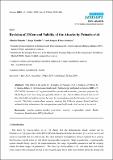Por favor, use este identificador para citar o enlazar a este item:
http://hdl.handle.net/10261/137433COMPARTIR / EXPORTAR:
 SHARE SHARE
 CORE
BASE CORE
BASE
|
|
| Visualizar otros formatos: MARC | Dublin Core | RDF | ORE | MODS | METS | DIDL | DATACITE | |

| Campo DC | Valor | Lengua/Idioma |
|---|---|---|
| dc.contributor.author | Peinado, Alberto | - |
| dc.contributor.author | Munilla, Jorge | - |
| dc.contributor.author | Fúster Sabater, Amparo | - |
| dc.date.accessioned | 2016-09-29T08:59:57Z | - |
| dc.date.available | 2016-09-29T08:59:57Z | - |
| dc.date.issued | 2015-05-22 | - |
| dc.identifier | issn: 1424-8220 | - |
| dc.identifier.citation | Sensors 15(5): 11988-11992 (2015) | - |
| dc.identifier.uri | http://hdl.handle.net/10261/137433 | - |
| dc.description.abstract | This letter is the reply to: Remarks on Peinado et al.’s Analysis of J3Gen by J. Garcia-Alfaro, J. Herrera-Joancomartí and J. Melià-Seguí published in Sensors 2015, 15, 6217–6220. Peinado et al. cryptanalyzed the pseudorandom number generator proposed by Melià-Seguí et al., describing two possible attacks. Later, Garcia-Alfaro claimed that one of this attack did not hold in practice because the assumptions made by Peinado et al. were not correct. This letter reviews those remarks, showing that J3Gen is anyway flawed and that, without further information, the interpretation made by Peinado et al. seems to be correct. | - |
| dc.description.sponsorship | This work has been supported by the MICINN under project “TUERI: Technologies for secure and efficient wireless networks within the Internet of Things with applications to transport and logistics”, TIN2011-25452. We acknowledge support by the CSIC Open Access Publication Initiative through its Unit of Information Resources for Research (URICI). | - |
| dc.publisher | Multidisciplinary Digital Publishing Institute | - |
| dc.relation.isversionof | Publisher's version | - |
| dc.rights | openAccess | - |
| dc.subject | Cryptanalytic attack | - |
| dc.subject | Pseudo random number generators | - |
| dc.subject | EPCglobal Gen2 | - |
| dc.subject | Radio Frequency Identification | - |
| dc.subject | Security | - |
| dc.title | Revision of J3Gen and Validity of the Attacks by Peinado et al. | - |
| dc.type | artículo | - |
| dc.identifier.doi | 10.3390/s150511988 | - |
| dc.relation.publisherversion | http://dx.doi.org/10.3390/s150511988 | - |
| dc.date.updated | 2016-09-29T08:59:58Z | - |
| dc.description.version | Peer Reviewed | - |
| dc.language.rfc3066 | eng | - |
| dc.rights.license | http://creativecommons.org/licenses/by-nc-sa/4.0/ | - |
| dc.contributor.funder | Ministerio de Ciencia e Innovación (España) | - |
| dc.contributor.funder | Consejo Superior de Investigaciones Científicas (España) | - |
| dc.relation.csic | Sí | - |
| dc.identifier.funder | http://dx.doi.org/10.13039/501100004837 | es_ES |
| dc.identifier.funder | http://dx.doi.org/10.13039/501100003339 | es_ES |
| dc.identifier.pmid | 26007740 | - |
| dc.type.coar | http://purl.org/coar/resource_type/c_6501 | es_ES |
| item.openairetype | artículo | - |
| item.fulltext | With Fulltext | - |
| item.grantfulltext | open | - |
| item.openairecristype | http://purl.org/coar/resource_type/c_18cf | - |
| item.cerifentitytype | Publications | - |
| Aparece en las colecciones: | (ITEFI) Artículos | |
Ficheros en este ítem:
| Fichero | Descripción | Tamaño | Formato | |
|---|---|---|---|---|
| sensors-15-11988.pdf | 198,31 kB | Adobe PDF |  Visualizar/Abrir |
CORE Recommender
SCOPUSTM
Citations
1
checked on 23-may-2024
WEB OF SCIENCETM
Citations
1
checked on 28-feb-2024
Page view(s)
381
checked on 22-may-2024
Download(s)
191
checked on 22-may-2024
Google ScholarTM
Check
Altmetric
Altmetric
Este item está licenciado bajo una Licencia Creative Commons

